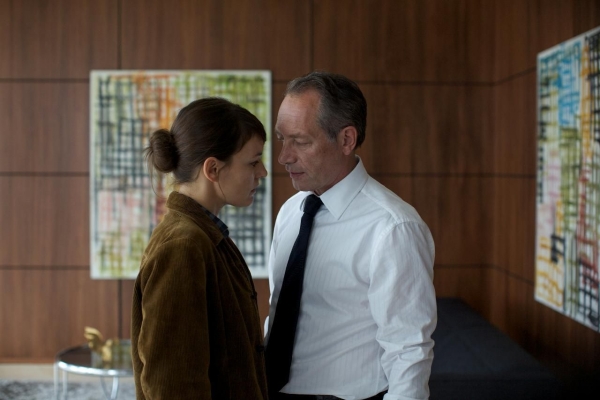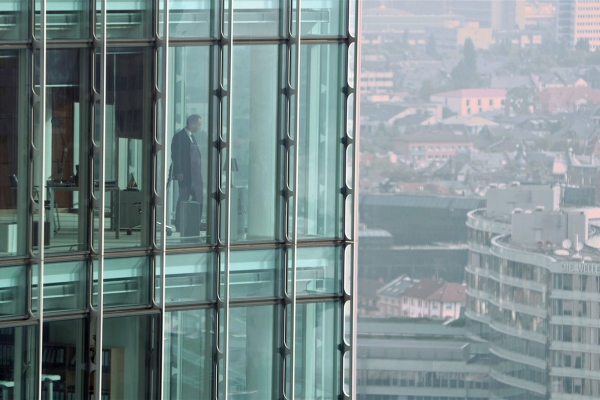The 1 Percent Solution
To start the New Year, the Museum introduces First Look, a new annual showcase curated by Dennis Lim, Rachael Rakes, and David Schwartz. This two-weekend program—which brings together some of the most invigorating and inventive voices in contemporary world cinema, including established and emerging filmmakers—affirms our belief in cinema as a flourishing art form. To supplement the program, Moving Image Source is running a series of essays on all the feature films that are being shown. Check back daily from now through next weekend for new articles.
The City Below is not Christoph Hochhäusler's latest film. In fact, it premiered at the Cannes Film Festival back in 2010. (His most recent effort, One Minute of Darkness [2011], is the third part of the Dreileben trilogy, which screened at this past year's New York Film Festival, among other engagements.) However, in the intervening 20 months, the world has changed around the film. This is no surprise; nothing ever stands still. But I would submit that The City Below is a stronger, more relevant, altogether more seductive film today than when it first appeared, and that in itself is saying something. What had, in May of 2010, been a sharp, summative, and rather surreal response to the 2008 financial crisis reads even more today like a prescient response to 2011's global Occupy movement, along with the numerous European and North American economic and political machinations that have precipitated its rise. (On a lesser note, The City Below also seems like an avant la lettre companion piece or psychological corrective to J. C. Chandor's Margin Call [2011].)
The truly odd thing about The City Below's specific political intervention, and its meticulous formal construction, is that Hochhäusler relies so heavily on the film's final minute and a half. A discordant, hard-to-place flash-forward, the scene finds the two main characters—Frankfurt power banker Roland Cordes (Robert Hunger-Bühler) and his lover, Svenja Steve (Nicolette Krebitz)—waking up in a hotel room after a night together. Just before this discontinuous scene, the two appeared to be on the verge of breaking off their affair. (Numerous lies had been revealed, most notably the revelation that Cordes had sent Svenja's husband, Oliver, a midlevel executive, to a dangerous job in Indonesia expressly to get him out of the way.) As Svenja wakes, she hears faint rumblings, white noise, some yelling on the street. Still naked apart from her panties, she goes to the window and peers through the blinds. On the pavement below, we catch a brief glimpse of total chaos. Men and women in suits and middle-class leisurewear and students with backpacks all run screaming through an abandoned intersection. Svenja, in close-up, turns toward Roland (and to us), quietly announcing, "It's begun." Cut to black. Credits.

Nicolette Krebitz and Robert Hunger-Bühler in The City Below
Although nothing up to this point in The City Below really prepares us for this moment of speculative dystopianism, it certainly doesn't come from nowhere. What it finally asks us to do is to retroactively reconsider everything we have witnessed, to think about it as a present-tense diegesis that, somehow, leads us to this unexpected future. What's more, on a formalist level, we must account for precisely how Hochhäusler's coda fits together with his film as a whole. The City Below is 105 minutes long. The discovery of the riot is approximately one minute. If we were to apply a somewhat free adaptation of Barry Salt's Average Shot Length analysis method, using it to measure scenes, rather than shots, in relation to the entirety of a film, then the apparent breakdown of civilization as we know it accounts for approximately 1 percent of the total running time. From the high-up window of a luxury hotel, a woman, currently "kept" by one of the richest men in Germany, calmly looks down at the plight of the 99 percent, one from which she is shielded, for now.
But let's back up a bit. As I say, this short, potent, puzzling scene is significant because of, not in spite of, all that came before it, and The City Below is by no means a tale of benighted lovers, a rich old man and a social climber successfully isolating themselves from the turmoil and tyranny of the material world. Svenja is in some ways a loving and dutiful wife, still trying to find her footing in Frankfurt, having just moved there with Oliver. When the film opens, he has just started his position at DEC Bank's Frankfurt office. Their furniture is still arriving; she has no friends or acquaintances yet, and no job. But on a much more profound level, Hochhäusler constructs Svenja as someone who does not know exactly who she is. This is not the crisis of identity that we have come to expect from the bourgeois cinema of interiority. Svenja doesn't cry, stare in the mirror, go to unfulfilling support groups, or, God forbid, cut her hair short. In an early sequence, she sits at a café table and notices a passerby wearing the same green top as her. Svenja immediately begins following this woman at a semi-discreet distance, looking in the same shops, following the same wandering itinerary.
Then, after noticing that Woman no. 2 stops in a pastry shop for a brioche, Svenja does the same. She takes a bite, spits it out in the wax wrapper, and tosses it in the trash. The scene, played not for pathos nor for comedy, but just as a banal daily activity, displays Svenja's mix of curiosity and emptiness, a generalized anomie and casting about for direction. Being in a new city, this is understandable. But as we learn more about Svenja, we begin to wonder whether marrying Oliver and following him around in the first place—first São Paolo, then Houston—is as much out of a lack of firm existential commitments as it is from her genuine affection for him. Just as in her affair with Roland, which begins with several rejections of his advances and an eventual capitulation that seems equally unmotivated, Svenja's actions—like moves within a game only she understands—display the signs of preference, or "reality testing" in Freud's terminology, but seldom if ever do they allow us to discern motivation, deep psychology, or a firm will.
So who is Svenja, and what is her social and economic relevance? One could argue that she is an object of exchange. This is a role that women are often asked (or forced) to play, within economic fields, among inter-male relationships, and within the circulation of images themselves, such as cinema. Svenja's relative ease in moving herself from Oliver to Roland, despite (or possibly in part because of) her loyalties, could be read as a latter-day, neo-liberal riff on Fassbinder's The Marriage of Maria Braun (1979), in which a woman sets herself up consciously as a chit, shuttled between men at different places in the economic order. However, where Maria was a tactician, an economic rational-actor in the classical Adam Smith model, Svenja really does seem to simply drift. Her anger upon learning that Roland engineered her husband's exodus from Europe appears genuine, as does Roland's desperation to win her back. But both of these expulsions of feeling lead us back to the placid sleep of the 1 percent, regardless of what may have happened in between.
Svenja, then, might best be understood as a placeholder, the spot where exchanges occur but where values are just designated as necessary, both by her and by those around her. If, in classical Smithian economics, gold was the guarantor of "intrinsic value," the end of the gold standard allegedly inaugurated the era of "fiat money," paper that had value in a trade economy because governmental agencies, such as the Federal Reserve, designated it thus. The degree to which "soft" vs. "hard" monetary policy was to blame for the 2008 crisis, to what extent, and whether or not quantitative easing efforts have exacerbated the crisis rather than prompted localized recoveries, is an issue beyond the scope of this essay. Suffice to say, there is a semiotic collapse that the hard-money proponents usually fail to recognize. "Gold" has no intrinsic value. (Only labor does.) But as philosopher Jean-Joseph Goux has articulated in his book Symbolic Economies, "gold" was at one time the master-term for economic meaning, just as the Phallus was the master-term for sexual legibility, God the master-term for all moral meaning, etc. For Goux, post-humanism and the neo-liberal economic turn are inextricably connected, and this is why, in Svenja, we see an unmoored subject whose sexual interests are what, in a more conventionally moralistic (and sexist) era, we would call "faithless." Her sense of identity "inside" is virtually equivalent to her peripatetic flâneuserie in the city "outside"; and she is as free flowing as a wire exchange.
By contrast, who is Roland Cordes? He is a somewhat more challenging puzzle since in certain ways he appears to be a fully functioning member of the financial ruling class. But in a way, he is a crucial variation on the sort of antihero who has tended to occupy Hochhäusler's films. Frank Molesch (Stefan Kurt), the escaped convict of Dreileben: One Minute of Darkness, and Armin Steeb (Constantin von Jascheroff), the confused teen of 2005's False Confessor, are figures bound to "guilt" which is not their own. By contrast, Cordes is a callous member of the ruling class. If this entails guilt, then Cordes is indeed guilty. But The City Below asks at what point he started, and stops, being this guilty man, and to what degree he is committed to "his" continued existence.
Named "banker of the year" by a prominent business magazine, chiefly due to his bank's role in a massive leveraged buyout, Cordes is seen both in "official" DEC Bank boardrooms and in seemingly exclusive meeting rooms, where champagne and lobster are served in the middle of the day. These antiseptic-looking private clubs, we discover, are where the deals are actually hatched. They exist on the 20th, 25th, or 30th floor of all-glass modernist skyscrapers, whose reflective surfaces echo the impervious remove of those inhabiting them. As Cordes confides to Svenja during one of their first private meetings, the offices of DEC look exactly the same in Frankfurt, London, New York, and the like, and so he often loses track of where in the world (of money-movement) he is. These are the common complaints not only of a man of Cordes's echelon but of the era more generally. We're heard them articulated before, in various forms. Jacques Tati's Play Time (1967) is the cinematic ur-text of spatial homogeneity. Critically, Marc Augé's Non-Places is the most comprehensive analysis of the problem in critical theory. So on this score, Hochhäusler is drawing on the known. We think we have Roland's number.

The City Below
But this garden variety alienation is actually that part of Roland Cordes that, like Svenja Steve's "good wife" persona, hews to an available script, where so much else is free-floating, unstable, without a fixed point of reference. For Roland, money should be the master-term that anchors all other decisions, and by extension, what personality he could be said to have. But his chance meeting with Svenja at an art museum lecture, followed by her presence with Oliver at a party at his home, shake him loose from his reference points. He confides that he wants to sleep with her; Svenja replies that "you cannot have everything." Roland rediscovers the pleasure and possibility of desiring, of having a space of exchange that is not automatically filled with the "instant transfer" (the neo-liberal substitute for the gold standard, the constant movement that conceals gaps in the economic field, without actually eradicating Lack).
However, Hochhäusler is not a romantic. Roland's desire for Svenja does not "save" him, or bring him back to life. It merely forces him to recognize the empty space, the sliding of no-master-term, that had calcified around financial pursuit. Who is Roland Cordes? When a banker is killed in Indonesia (for, we learn later, the bank's extraction of the nation's liquidity in the interest of global profit), Roland takes Svenja to that man's childhood home and passes the dead man's life story off as his own. Who is Roland Cordes? With proper protection, he periodically ventures out of his glass towers and down into the street, to the very slums that his strategic planning no doubt helped to create. He watches in fascinated horror as strangers flop out on bug-infested mattresses and shoot heroin. Who is Roland Cordes? In time, he resigns from the bank, striving to win Svenja back, not as a captain of high finance, but just a man, rather too old for her, somewhat melancholic, and clearly unsure of who or what he is or ever was.
In the end, The City Below is showing us something much more problematic, and much more exciting, than postmodern ennui. We know that men like Roland Cordes exist, and that women like Svenja Steve mindlessly orbit them, and that these people make life difficult, if not unbearable, for the vast majority of us. But these two disintegrating characters eventually drift away from privilege. They are not revolutionaries—they are not focused or even present enough to reflect on their own position—but their position of privilege, their class, is gradually being disarticulated. This mental disarray, the vague but ineluctable knowledge that things are no longer making sense as perhaps they once did, is a vital "task," if we can call something so unconscious a task. It is probably best described as a pressure, and Hochhäusler is showing us, throughout The City Below and in its final minutes, both the 99 percent running roughshod over the old system and the 1 percent morphing into something as yet undetermined. The real solutions will always be on the ground, but above us in those glass towers, power resides. That power must discover itself to be fundamentally imaginary. ![]()
LATEST ARTICLES
-20140814-173707-thumb3.jpg)
Fighting Words
by Imogen Sara Smith
posted August 12, 2014

Fighting Words, Part 2
by Imogen Sara Smith
posted August 20, 2014

On the Margins: The Fil…
by Andrew Chan
posted August 12, 2014

Robin Williams: A Sense…
by David Schwartz
posted August 12, 2014
 The 1 Percent Solution
The 1 Percent Solution
RELATED ARTICLE
Her Own Devices by Robert KoehlerCapitalist Punishment by Shelly Kraicer
Twilight Zone by Robert Koehler
Family Viewing by Mark Peranson
A Nude by Garrel by Eugenio Renzi
Unplugged by Phil Coldiron
Island Time by R. Emmet Sweeney
Ghost World by Colin Beckett
Darkness Doubled by Leo Goldsmith
Jungle Fever by Andréa Picard
Going the Distance by Scott MacDonald
Glass Houses by Michael Sicinski
The Fallen by Phil Coldiron
More: Article Archive
THE AUTHOR
Michael Sicinski is a film writer and teacher based in Houston, Texas. He is a frequent contributor to Cinema Scope, Cineaste, and GreenCine Daily.
More articles by Michael Sicinski
